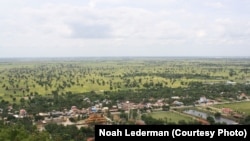The impact of genocide is not only horrific and devastating at the time, but for decades after the atrocities end. It has been witnessed by survivors still alive today in Europe, Africa and Asia. The effects of Cambodia’s violent history during the reign of the Khmer Rouge in the 1970s remain among its survivors and their successive generations. Noah Lederman is a travel writer and author of the e-book Traveling the Cambodian Genocide. His guide is informative both for travelers seeking to visit some of Cambodia’s darkest areas and for readers in general who want a sense of what Cambodians endured and life there remains affected decades later. Lederman told VOA’s Jim Stevenson how research into his family’s past opened an interest in what happened in Southeast Asia.
STEVENSON: A lot of the locals wanted to keep the stories basically to themselves. How open were they eventually in telling you their stories and showing you specific locations?
LEDERMAN: The longer you spent with somebody, the more comfortable they became. Certain people definitely opened up. We (Lederman and his wife) got to know one of our tuk tuk drivers. Instead of spending the day in the tuk tuk when we went off on a long hike, he wanted to join us. On that hike and everywhere we went, someplace kind of connected him with a past story. That is when the stories flowed just by spending the day with him. He invited us back to his house and the stories just kept coming.
STEVENSON: Did you find that some of the young people are learning some of these stories from the older people who obviously know them?
LEDERMAN: I think many of them do know what happened. But as one of the survivors had pointed out to me, I don’t think they understand why any of this had happened. The propaganda that is disseminated by the current government and the ignorance that they hope the people will have. The government was involved in some way, many of them with the Khmer Rouge when they were younger. Obviously they were brainwashed young men themselves. But this level of embarrassment that would go along with a proper education would really shine a light on some of the people in charge… A teenager walked up to us and he showed me a book by a survivor of the Cambodian genocide. He was showing me a pirated version of the book and he was trying to get me to buy it. When we asked what he was learning in school about history, he said they only learned about ancient history. Through conversation he revealed that what happened in the 1970s is not going to make money for these kids when they go off to maybe become tour guides in the future.
STEVENSON: This trip must have had a tremendous personal impact on you, and your perceptions of Cambodia before and after your visit.
LEDERMAN: I don’t know if I was really shocked by any of the sights. I kind of knew what to expect. I was more shocked by the people. The government is really corrupt. They are silencing peaceful protestors who are trying to fight for fair working wages and other people who are trying to challenge Hun Sen, the Prime Minister. Despite corruption, despite poor education, despite having one-third of all Cambodians living on less than a dollar a day, despite the health care system being one that allows for the highest infant and child mortality rates in the region, I think Cambodia has a really optimistic people.
STEVENSON: A lot of the locals wanted to keep the stories basically to themselves. How open were they eventually in telling you their stories and showing you specific locations?
LEDERMAN: The longer you spent with somebody, the more comfortable they became. Certain people definitely opened up. We (Lederman and his wife) got to know one of our tuk tuk drivers. Instead of spending the day in the tuk tuk when we went off on a long hike, he wanted to join us. On that hike and everywhere we went, someplace kind of connected him with a past story. That is when the stories flowed just by spending the day with him. He invited us back to his house and the stories just kept coming.
STEVENSON: Did you find that some of the young people are learning some of these stories from the older people who obviously know them?
LEDERMAN: I think many of them do know what happened. But as one of the survivors had pointed out to me, I don’t think they understand why any of this had happened. The propaganda that is disseminated by the current government and the ignorance that they hope the people will have. The government was involved in some way, many of them with the Khmer Rouge when they were younger. Obviously they were brainwashed young men themselves. But this level of embarrassment that would go along with a proper education would really shine a light on some of the people in charge… A teenager walked up to us and he showed me a book by a survivor of the Cambodian genocide. He was showing me a pirated version of the book and he was trying to get me to buy it. When we asked what he was learning in school about history, he said they only learned about ancient history. Through conversation he revealed that what happened in the 1970s is not going to make money for these kids when they go off to maybe become tour guides in the future.
STEVENSON: This trip must have had a tremendous personal impact on you, and your perceptions of Cambodia before and after your visit.
LEDERMAN: I don’t know if I was really shocked by any of the sights. I kind of knew what to expect. I was more shocked by the people. The government is really corrupt. They are silencing peaceful protestors who are trying to fight for fair working wages and other people who are trying to challenge Hun Sen, the Prime Minister. Despite corruption, despite poor education, despite having one-third of all Cambodians living on less than a dollar a day, despite the health care system being one that allows for the highest infant and child mortality rates in the region, I think Cambodia has a really optimistic people.















